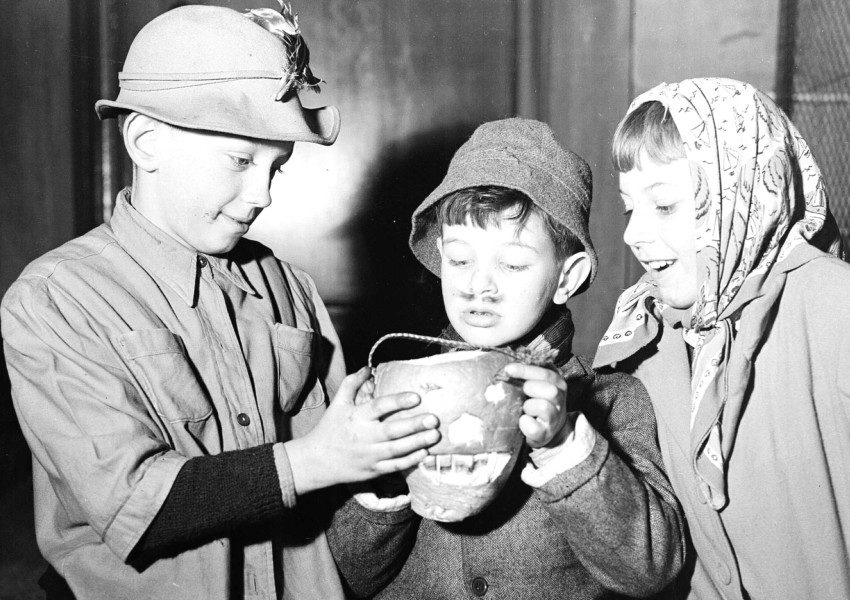Halloween, or All Hallows Eve, is the beginning of a Christian festival of remembrance in which many countries around the world pay homage to the dead, lost souls and on the 1st November in particular, the saints and martyrs on All Saints' Day.
However, the timing of this event is widely believed to have been deliberately chosen to coincide with Samhain, an ancient Celtic festival which marked the end of summer, celebrated the harvest and heralded the coming of winter, in a bid to help further integrate the local populace with the church.

Edinburgh guisers warm their hands over their tumshie lantern in 1956. Picture: TSPL
As a result the origins of many of the practices which survive today (in their increasingly Americanised form) can be found in the rituals which originally took place during this time.
The calendar in those days was closely tied to the seasons both in terms of growing and in the ideas of the changing year, and Samhuinn - the term used by Scots druids which loosely translates as ‘summer’s end’ - would have celebrated the harvest and the bounty they would need to survive the winter.
• WATCH: Forget carving pumpkins, hilarious video shows how Scots celebrate Halloween
It was also regarded as a liminal time by the highly superstitious Celts who saw this time of the year as a weakening of the boundary between the world of the living and the world of the dead, and a time when those from the latter could cross into the former.
As a result, the villages and communities would create large bonfires to ward off those evil spirits, faeries and witches using the cleansing power of fire.
All house fires were also put out and new fires were then lit from these great bonfires, to bring protection into the home.
Long before carving pumpkins became a prominent part of Halloween for Americans, Scots (and the Irish) were creating lanterns by carving turnips to celebrate Samhain.
The rutabaga swede, known in Scotland as neep or a tumshie, was carved and a candle inserted inside and adapted as a way to ward off the spirits of the dead at this time of year in the place of the old rituals of bonfires (which perhaps coincidentally went on to become a huge part of the Guy Fawkes celebrations on the fifth of November).
The arrival of the pumpkin lantern came much later, when the Scots and Irish would have immigrated to the US taking their traditions with them and finding pumpkins, squashes and gourds to be far more numerous (and easier to carve than their transatlantic cousins).
Interestingly, the name Jack O Lantern comes from an Irish folk tale and would have been mixed in with those other traditions that came from Scotland when both nationalities settled in North America.
The practice has now, as these things often do, has gone full circle and the pumpkin has become by far the most popular vegetable for lantern carving on this side of the Atlantic too now, overtaking the traditional neep or potato as the vegetable of choice.
For many Scots however, the tumshie remains at the heart of their Halloween celebrations and the aroma of burning neep remains as the unmistakable scent of Halloween.

Picture: William Warby\Flickr
Guisin' and Galoshin' - or trick or treating as it's known in the US - would probably have originated in the need for villagers to "hide" themselves and avoid being "taken" by the evil spirits around Samhain, when they went abroad at night to fulfill vital tasks.
The young men of the village would don grotesque masks or use soot to blacken their faces before heading out.
The practice of door knocking is believed to have come from the village elders and pagan druids collecting food for the Samhain feasts or gathering offerings for the aos sí (fairies) to ensure the community's livestock survived the winter.
The close association with Samhain - pronounced Sow in - saw other practices carry through into Halloween celebrations such as the use of apples and nuts to predict the future.
Apples
Take your apple and divide it into nine segments. Eat eight pieces standing with your back turned to a mirror then throw the ninth portion over your shoulder. When you turn round you will see the face of your intended in the mirror. (Honest!). Alternatively you can peel the apple, throw the peelings over your shoulder where the initial of your loved one's surname will be revealed.
Nuts
Another way to find out whether you'll have a happy future is to place two hazelnuts on the embers of a fire. Name one nut after yourself and the other after the significant other in your life. If you're mismatched then the nuts will jump about and split apart. If they remain constant and side-by-side, then you are clearly a good couple.
If you're lucky you can still find Halloween parties where you can divine your future from a bowl of mashed potatoes (or fuarag as it is known in the Highlands).
Various charms are hidden in the spuds and everyone given a spoonful. Your future depends on the charm you find; a coin denotes wealth, a button batchelordom, ring marriage – just be careful you don't swallow it.
